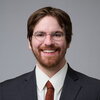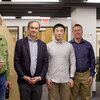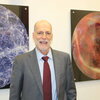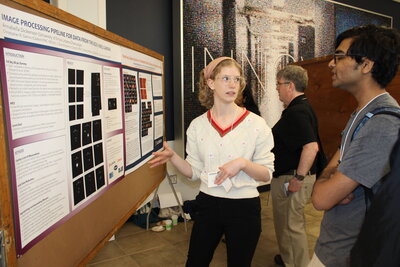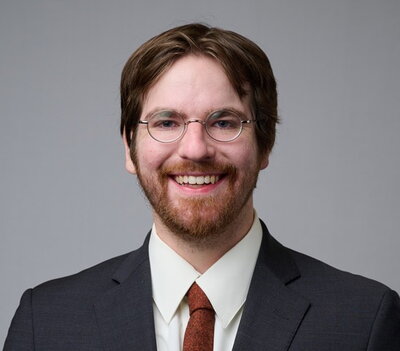

Patrick Aleo (PhD, astronomy ’24) still remembers the first time he looked through a telescope. He was in elementary school when his parents bought one for his brother, and one night, he took a turn at the eyepiece.
“I looked at the full moon and I was transfixed,” he recalled. “Before that, things in space never felt real or tangible. From then on, whenever someone asked what I wanted to be when I grew up, I’d say an astrophysicist.”
That early glimpse of the moon set Aleo on a path that eventually led to a PhD in astronomy from the University of Illinois Urbana-Champaign—and, perhaps less predictably, to his current role as a senior data scientist at Honeywell Federal Manufacturing and Technologies, the primary contractor for the Kansas City National Security Campus.
In his current role, Aleo works with massive, complex datasets—millions of parts and thousands of inspections performed daily by supervisors and technicians. “I’m trying to make efficiencies in our manufacturing process,” he explained. “Everything from tracking to non-conformance detection, to predictive analytics, to larger aggregate statistics.”
While the data is very different from supernovae, the skills behind the work aren’t.
Building a data-driven PhD
Aleo’s interest in data science took root during his senior year at the University of Texas at Austin, when he worked with professor Milos Milosavljevic, one of the early adopters of machine learning in astronomy. “He taught a course that showed how these techniques were being applied in other fields and how the same statistical approach could connect them,” Aleo said. “I thought it was such a cool concept—that if I had this one tool, I could apply it to all these different fields and think about problems in a new way.”
When he arrived at Illinois, Aleo joined the Advanced Visualization Lab at the National Center for Supercomputing Applications, where he worked on translating astrophysical simulations into cinematic science visualizations for museums and documentaries. Later, when professor Gautham Narayan joined the astronomy department, Aleo found a mentor who helped him merge his interests in astronomy and data science.
“I told him, ‘I find your research interesting, but I don’t really see myself becoming a professor. Could we structure my PhD so that I could be a data scientist applied to astronomy?’ and he said, ‘I’m game. Let’s do it,’” Aleo said. “So we built my PhD around the techniques that would prepare me for whatever field I found myself in.”
That work included leading the first data release for the Young Supernova Experiment—an accomplishment Aleo still calls one of his proudest. “It was about a year and a half of work to put out one of the largest and most robust samples of supernovae in the literature,” he said. “Taking something from raw data to something people are now using to train other models was incredibly rewarding.”
He also collaborated with international teams, such as the SuperNova Anomaly Detection group, where he led virtual meetings across multiple continents and time zones. Those experiences, he said, “really helped me learn how to work collaboratively when everyone’s far apart,” a skill that translated seamlessly to industry.
From the classroom to the industry floor
As Aleo neared the end of his PhD, he began preparing to enter the data science job market. “I started applying in my last year to get a head start,” he said. “I was doing a lot of studying for coding interviews and figuring out how to communicate my technical research in a more palatable way for industry.”
That ability to bridge the communication gap was one of the most important skills he developed. “I learned to leave out the jargon and highlight key ideas,” he said. “Astronomy actually made for a great entry point—people found it fascinating. If you tell them you studied exploding stars, their ears perk up.”
Once he had their attention, he learned to translate his experience in terms any organization could value: making sense of messy data, isolating the real drivers of problems, and communicating results clearly. “That’s what people in the company above you want to know,” he said.
From his PhD days, Aleo also carried a deep sense of independence and rigor forward. “Having the PhD where you’re an independent researcher—you learn how to navigate and find that next step,” he said. “All those skills I use every day.”
Of all the lessons he carried from graduate school, one of Narayan’s mantras continues to echo in Aleo’s mind: ‘Look at your data.’ “People trust you to be the most fluent about your data,” Aleo said. “I always feel like I have Gautham’s voice in the back of my head telling me to make sure I really know what my data says.”
Staying connected—and looking ahead
Even as his career has moved beyond academia, Aleo stays connected to the field that first inspired him. He keeps in touch with former classmates, occasionally serves on early-career industry panels, and was featured on an episode of the Astronomers Turned Data Scientists podcast.
These days, however, Aleo’s attention is also turning toward a much more immediate horizon—he and his wife are expecting their first child any day now. “I have all the emotions right now,” he admitted. “I’m excited, certainly a little nervous.”
